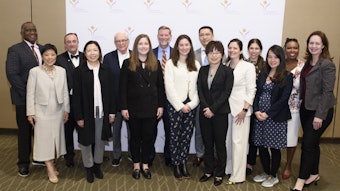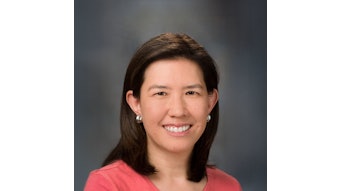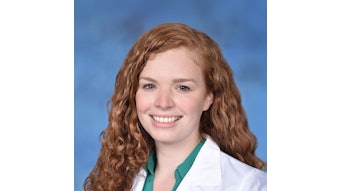An Alternative Approach to Preventing Ovarian Cancer?
The ongoing TUBA-WISP II study could point the way to a new preventive approach for those at high risk for tubo-ovarian cancer.

The late onset of symptoms and a lack of screening possibilities make tubo-ovarian cancer one of the deadliest forms of gynecological cancer. Current guidelines advise individuals with an increased inherited risk for ovarian cancer — such as those who are carriers of the BRCA1 and BRCA2 pathogenic variant — to undergo a risk-reducing salpingo-oophorectomy (RRSO), which is 96% effective. The downside is, the surgery also induces premature menopause, which can include complications both short term (menopausal and sexual complaints) and long term (higher risk for cardiovascular disease, osteoporosis, and cognitive issues).
Since the discovery of the serous tubal intraepithelial carcinoma (STIC) in 2001, it has become clear that the fallopian tube and not the ovary is the tissue of origin of tubo-ovarian cancer oncogenesis (Piek et al). This has led to an alternative treatment strategy — a risk-reducing salpingectomy (RRS) with a delayed oophorectomy (DO) — that could reduce the risk of the potential consequences of premature menopause. That treatment is the subject of Saturday’s late-breaking abstract presentation, “Early salpingectomy with delayed oophorectomy as alternative for risk-inducing salpingo-oophorectomy – the first 2,000 participants in the ongoing international TUBA-WISP II study.”
Coordinating study investigator Tamar Gootzen, MD, (on behalf of associate professor Joanne de Hullu, MD, PhD, principal investigator), said the study, which is currently under way, could signal a shift toward a more personalized — rather than one size fits all — approach to ovarian cancer prevention. This in turn could benefit patients earlier in life.
“Women are advised to undergo an RRSO around the age of 40; therefore, this has a lot of impact on their lives,” she said. “With the TUBA-WISP II study, we are investigating an alternative strategy: first, removal of the fallopian tubes, and the ovaries later. This has a positive impact on menopause-related quality of life and sexual functioning in these women, which we published in previous studies.”
The first 2,000 patients in the study were recruited from 45 centers in 11 countries. They were individuals who had an increased inherited risk for tubo-ovarian cancer. Because the lifetime risk for tubo-ovarian cancer varies, depending on which pathological variant they carried, these individuals are eligible for inclusion at different ages:
- 25-40 (BRCA1)
- 25-45 (BRCA2)
- 25-50 (RAD51C/D, BRIP1, PALB2)
RRS was performed after completion of childbearing and up to and including the ages of 40 (BRCA1), 45 (BRCA2), or 50 (RAD51C/D, BRIP1, PALB2) with a delayed DO surgery up to a maximum of five years beyond the upper limit of the current guideline age for RSSO. The primary outcome is noninferiority of RRS/DO compared to RRSO in BRCA1 and BRCA2 carriers in regard to tubo-ovarian cancer risk as estimated by the cumulative tubo-ovarian cancer incidence target age 46 (BRCA1) and 51 (BRCA2).
Of the 2,000 patients selected, 1,035 (51.7%) had a BRCA1 pathologic variant, and 916 had the BRAC2 pathologic variant. In addition, 15 RAD51C carriers, seven RAD51D carriers, 21 BRIP1 carriers, and five PALB2 carriers were included. Most participants (75.9%) chose RSS surgery with DO over the standard RRSO (24.1%). Thus far, eight high-grade serious carcinomas (HGSCs) have been diagnosed at first surgery: four in the RSS/DO group and four in the RRSO group. In addition, seven isolated serous tubal intraepithelial carcinomas have been diagnosed in the RRS/DO group, with three in the RRSO group.
Because the study is ongoing, Dr. Gootzen, who is a PhD candidate in gynecological oncology at Radboud University Medical Center in Nijmegen, Netherlands, said it is too early to draw any conclusions from the data as the participants are still too young and follow-up time is too short. Therefore, it is important that RRS with DO is only executed within the limits of a clinical trial. Inclusions will be finished in approximately two years. After that, it will be about 10 years until the results of the primary outcome are known. In the meantime, the researchers are preparing a subsequent study after finishing the inclusions to keep the option of RRS with DO within the protection of a clinical trial.
Dr. Gootzen said the work in this area builds upon studies that go back 20 years and will lay the groundwork for future studies to come.
“Piek et al identified that the high-grade serious carcinoma subtype of ovarian cancer originates in the fallopian tube, rather than the ovary. Over time, important questions about the potential for improved preventative strategies for high-risk women were raised,” Dr. Gootzen said. “Therefore, in 2014, our research group started by conducting interviews with patients to explore the feasibility of a novel approach — salpingectomy with delayed oophorectomy — as an alternative to salpingo-oophorectomy.”
Dr. Gootzen said subsequent studies by the Radboud University Medical Center research team and others have examined the impact of this approach on both quality of life and sexual functioning, which ultimately led to the next step of evaluating the safety of this new approach in the international TUBA-WISP II study.
“As the healthcare paradigm gradually shifts from a solely treatment-focused approach to one that also incorporates prevention and quality of life, this study aligns well with contemporary research trends,” she said. “The increasing focus on patient empowerment and shared decision making is central to this study, as it allows women to choose the preventative strategy that best suits their individual needs and preferences.”
View abstract presentation slides and session recordings on the event platform. Recordings will be available within 24 hours and accessible for 90 days.











